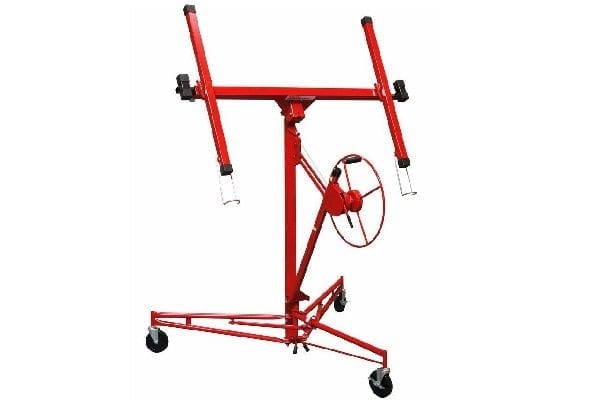
Perfecting the Drywall Lift
They’re heavy. They’re floppy. That’s right – drywall can be a cumbersome one-man job. And while you typically want to have some reinforcements, there are times when it’s just you, the drywall and the ceiling. And there is where you need a drywall lift.
A drywall lift can help place your drywall into the right position. If you don’t have a lifting tool handy, you can even make your own ad hoc drywall lift.
When using a machine, get your lift ready, release the catch on the wheel, and do a dry run. Crank the lift up and down a couple of times to make sure it’s working smoothly. Next, lock the lift and hoist one end of the drywall sheet up to the support hook—finish side down.
Make sure you flip down the support hooks to hold the sheet. Place the face of the sheet against the lift. Lift the other end of the sheet up and slide it onto the second. Lift slowly and smoothly so that it doesn’t fall off the edge of the hook.
Tip the sheet so it’s horizontal and lock it down. Next, wheel the lift into approximate position. Because drywall lifts are stable and maneuverable, you can fine-tune the placement when you raise the drywall. Crank it tightly. (Note: You may need to get up on a ladder to nudge the sheet into place).
Put in at least eight screws before lowering the lift.
Tip the sheet against the wall. Extend the support arms to suit 8 or 12-ft. sheets.
For wall placement, tip the sheet against the wall and extend the support arms to fit the size of the sheet (8-foot or 12-foot sheets).
After loading the drywall, push the lift to the wall, position the sheet, tip the top edge against the wall and crank it snugly against the ceiling.
Lifters work, too
If you want to alleviate the entire lifting process, you can use a panel lifter, too. This enables you to lift and carry without all of that unnatural arm-stretching and torso-twisting.
Simply hook the panel lifter around the bottom of the sheet at the center point, tip the sheet up and lift. Remember to leave your lifting arm fully extended (imagine carrying a briefcase).
Next, use your other arm to balance the sheet while keeping the drywall close to a horizontal position.

